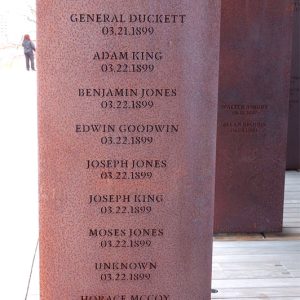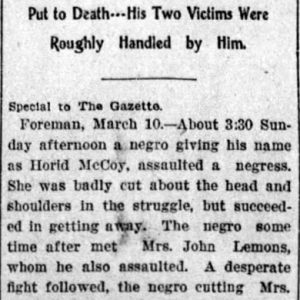calsfoundation@cals.org
Hosey McCoy (Lynching of)
On March 9, 1902, an African American man named Hosey McCoy was lynched in Little River County for allegedly having raped a white woman.
A relatively detailed account of the event was published in the March 13, 1902, edition of the Fort Smith Times. This account relied upon “authentic advices” received at Texarkana (Miller County) from New Rocky Comfort—now Foreman (Little River County)—on the morning of March 10 and later transmitted onward. According to this account, the woman “criminally assaulted” was one “Mrs. John Lemon, a white woman and wife of a drummer.” This was perhaps Dora Lemons, age twenty-two, who is listed in the 1900 census as the wife of a John Lemons of Little River County, age twenty-nine, whose occupation was listed as salesman (a drummer was a particular kind of salesman). Her alleged assailant was named in the Fort Smith Times as Hosey McCoy, described as “a railroad hand from Ozan.” There was a large Black family of McCoys living in Ozan (Hempstead County) on the 1900 census, but none were named Hosey or any similar variation, such as Hosea.
According to the account in the Fort Smith Times, on March 9 at around noon, Lemon was walking along the railroad tracks to visit a neighbor when McCoy “seized the woman and dragged her into the woods and criminally assaulted her.” She was found at about 4:00 p.m., still unconscious, but she had reportedly, while being dragged away, torn off bits of her clothing, creating a path for the eventual search party. The paper reports, “The neighborhood was at once scoured for the negro,” without explaining how suspicion had fallen upon McCoy. A man named Thomas Donohoe found him, and he was captured.
At about 11:00 at night, a mob of approximately 250 white men took McCoy to the edge of town (apparently New Rocky Comfort), where he was “positively identified by his victim, and was then hung to the limb of a tree.” In keeping with the tropes of many lynching reports, the paper reported, “There was no shooting, the lynchers quietly doing their work.” McCoy was left to hang for an hour and “was then cut down, and the body was turned over to the members of his own race.”
However, according to a report published in the Arkansas Gazette, the lynching victim was named Horid McCoy. The accounts of his crime differ, too. First, he allegedly assaulted “a negress,” whose name is not given, around 3:30 p.m. on March 9. She experienced cuts “about the head and shoulders” but managed to get away. Then he came upon “Mrs. John Lemons” and cut her “about the head, neck and shoulders.” The crime of rape is not specified. The Gazette also claims of McCoy: “Little is known of the mob’s victim or of his antecedents. He appears to have been a stranger in this vicinage.”
Another variation upon the story was published much later in the Osceola Times, which also reported that McCoy had assaulted two women, the first African American and the second white, and that he only seriously injured the latter; before he was hanged, he was presented to both victims, who identified him.
For additional information:
“Little River Lynching.” Fort Smith Times, March 13, 1902, p. 4.
“Negro Lynched Near Foreman.” Arkansas Gazette, March 11, 1902, p. 1.
“Negro Mobbed at Foreman.” Osceola Times, March 22, 1902, p. 3.
Staff of the CALS Encyclopedia of Arkansas
 Civil Rights and Social Change
Civil Rights and Social Change Early Twentieth Century, 1901 through 1940
Early Twentieth Century, 1901 through 1940 Little River County Lynching
Little River County Lynching  Hosey McCoy Lynching Article
Hosey McCoy Lynching Article 




Comments
No comments on this entry yet.